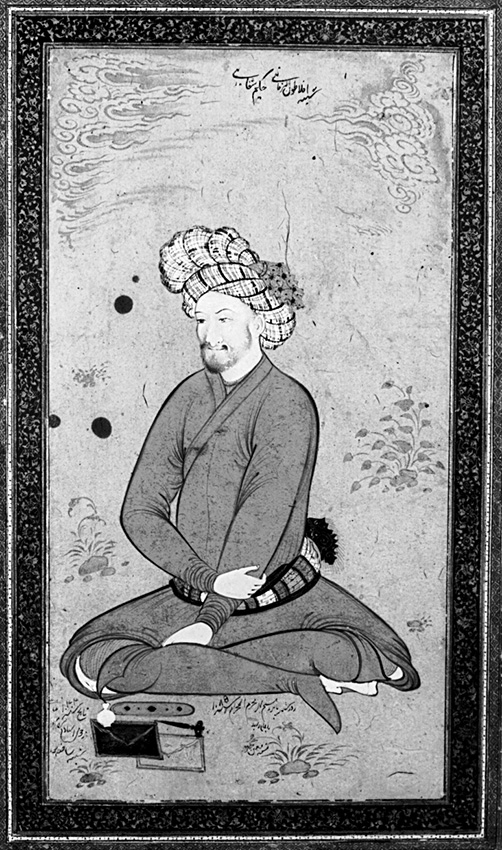Moʿin Moṣavver | Individual Drawings and Paintings
Painting 1674.1
Portrait of Ḥakim Šafʿi Eṣfāhāni
Location: Current whereabouts unknown. Formerly Geneva, Collection of Prince Sadruddin Aga Khan Ir.M.95.
Painting: (H x W) 18.5 x 9.8 cm., page 30.5 x 21.1 cm.
Signature: Signed and dated 1085/1674.
Inscriptions
-- Top center: šebh-e aflātun al-zamāni ḥakim-e šafāʿi. Translation: “Portrait of the Plato of his time, Doctor Šafāʿi”.
-- Bottom left: tāriḵ-e sana 1044 ...[illegible] ... oståd [ostådam?] reżā-ye ʿabbāsi šabi sāḵta bud. Translation: “Copied [from a painting] from the year 1044/1634 by [my?] master Reżā ʿAbbāsi.”
-- Bottom center: ruz-e šanba pānzdahom-e šahr-e moḥarram al-ḥarām sana 1085 ba etmām rasid mašqa moʿin-e moṣavver. Translation: “Completed on Saturday the fifteenth of the holy month of Moḥarram in the year 1085/21 April 1674. Copied by Moʿin Moṣavver.”
All three inscriptions appear to be in Moʿin’s handwriting.
Description:
The subject is portrayed sitting cross-legged on the ground, facing slightly towards the left. He is a man of middle age with a neatly trimmed full beard and mustache, wearing a variegated turban, a light brown tunic tied at the waist with a variegated sash, and blue stockings. The background is beige with suggestions of stylized clouds, plants, and stones. On the ground before him is a pen box, ink well, pen, and two envelopes.
Bibliography:
Arnold, Journal_1916, p.70 and pl.1.
Quaritch, Catalog, no.512. (incomplete citation)
Kühnel, Pantheon,_1942 ,p.113.
Stchoukine, SA_1964, pp.67-68.
Sotheby Sale Catalog (London), 7 April 1975, Lot 53.
Welch, AK3_1978, Ir.M.95.
Welch, Islamic Book_1982, no.41 (ill.).
Commentary:
Welch cataloged this painting in the Aga Khan's Collection in 1978 and even identfies it as collection number Ir.M.95, and again makes
reference to it in 1982. The bulk , if not all, of the Aga Khan's collection was endowed to the Aga Khan Museum in Toronto which opened in 2014. The Museum claims that Ir.M.95 is not in their collection. What happened to it in the intervening years is not known to us.
There has been some confusion over the years about the identification of the subject here portrayed, and the artist to whom the painting should be attributed. This confusion was the result of various interpretations of the inscriptions, and the existence of two variants of the same subject, one in the British Museum (no. 1920-9-17-098(2)), and another in the Bibliothèque Nationale (Suppl. persan 1572, folio 3). Arnold was first to publish the present miniature, and reached two conclusions: first, that the painting was a copy by Moʿin of an original picture by Reżā ʿAbbāsi in the British Museum, and secondly, that the inscription at the top did not give the actual name of the subject. Presumably, he chose to interpret šafā¯i in its literal sense as “one who cures” rather than as a name. Since the inscription refers to the personage as “the Plato of his time”, Arnold associated him with Mirzā Moḥammad Širāzi, doctor to Shah ʿAbbās, who is similarly referred to in the ʿĀlam ārā-ye ʿAbbāsi. This reasoning seems convoluted. An inscription on the British Museum variant cited by Arnold clearly states the subject to be Ḥakim Šafāʿi, and that it was drawn by Reżā Moṣavver, a relatively obscure but known painter. When Roger Savory published the British Museum variant (Safavids_1980, pl.30), he identified the subject as the poet laureate Šafāʿi, apparently taking the inscription at face value, and identifying him as yet another physician of Shah ʿAbbās, also cited in the ʿĀlam ārā-ye ʿAbbāsi (Savory, SA_1979, p.1308), Ḥakim Šafāʿi Eṣfahāni, poet/physician who attained the rank of poet laureate before he died in 1037/1627-28.
There are several factors supporting this identification. First, it would be senseless for Moʿin, who was usually quite precise in the details of his inscriptions, to state “the portrait of ...”, and then not give the subject’s name. Secondly, Safavid historiographers commonly embellish the name of all they describe with the highest form of praise; “the Plato of his time” would seem to be a ubiquitous appellation applicable to more than one person. Thirdly, Šafāʿi is a fairly common name in Safavid times, and one is more apt to find it used as such rather than implying literal interpretation. And lastly, the objects spread on the ground before the subject - pen box, pen, ink well, and paper - are the attributes of a poet, which Šafāʿi was, and Širāzi was not. Thus, it would appear that the miniature is exactly what the inscriptions claim it to be, a portrayal of Ḥakim Šafāʿi, executed by Moʿin Moṣavver in 1085 after a painting of the same subject by Reżā ʿAbbāsi. The original 1044/1634 miniature by Reżā, now unknown, had to have been completed posthumously since the subject died seven years earlier. The version in the British Museum appears to be another variant executed by Reżā Moṣavver based upon the same ʿAbbāsi original. And the third miniature of the same subject, in the Bibliothèque Nationale, which has an effaced inscription no longer legible, would appear to be yet another variant based upon the same source and executed by some yet unidentified artist.
Photo after Welch, Islamic Book_1982, no.41
Robert Eng
Last Updated: January 7, 2019 | Originally published: January 7, 2019
